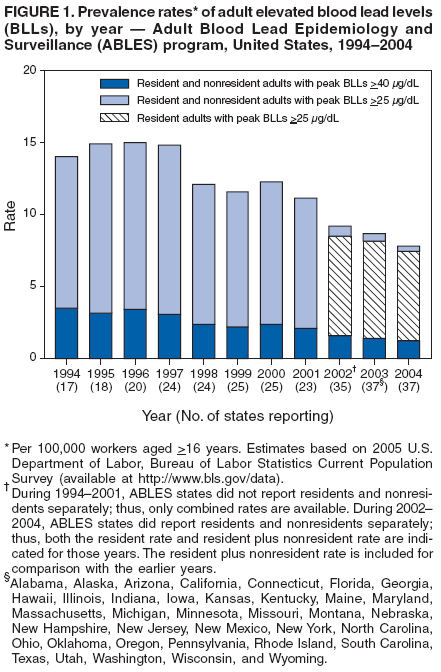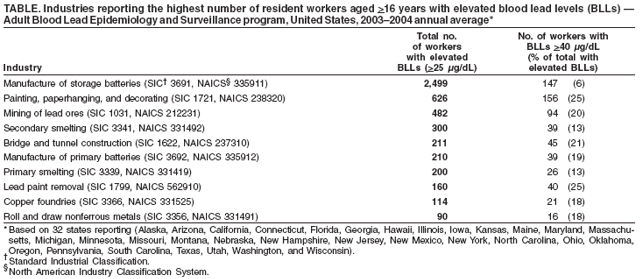 |
|
|
|
|
|
|
| ||||||||||
|
|
|
|
|
|
|
||||
| ||||||||||
|
|
|
|
|
Persons using assistive technology might not be able to fully access information in this file. For assistance, please send e-mail to: mmwrq@cdc.gov. Type 508 Accommodation and the title of the report in the subject line of e-mail. Adult Blood Lead Epidemiology and Surveillance --- United States, 2003--2004Since 1994, CDC's state-based Adult Blood Lead Epidemiology and Surveillance (ABLES) program has been tracking laboratory-reported blood lead levels (BLLs) in U.S. adults. A national public health objective for 2010 (objective 20-7) is to reduce the prevalence of BLLs >25 µg/dL among employed adults to zero (1). A second key ABLES measurement level is a BLL >40 µg/dL, the level at which the Occupational Safety and Health Administration (OSHA) requires workers to have an annual medical evaluation of health effects related to lead exposure (2,3). A previously published ABLES report provided data collected from 35 states during 2002 (4). This report summarizes ABLES data collected from 37 states* during 2003--2004 and compares them with annual data collected since 1994. The findings indicated that the national rate of adults with elevated BLLs (i.e., >25 µg/dL) declined from 2002 to 2003 and declined further in 2004. Projections using 1994--2004 ABLES data trends indicate that the national prevalence rate of adults with BLLs >25 µg/dL will be approximately 5.7 per 100,000 employed adults in 2010. Increased prevention measures, particularly in work environments, will be necessary to achieve the 2010 objective of reducing this rate to zero. Changes in MethodsThis report reflects three changes in ABLES analytic methods. First, state rates for persons with elevated BLLs now focus on residents of the states reporting them; previously, state rates were for state residents and nonresidents combined. Second, the annual national prevalence rate was calculated using the combined number of persons with elevated BLLs from all 37 states divided by the combined employed populations of those states; previously, the average state rate was presented as the national rate. Third, the denominators used in state and national rate calculations were determined using updated Bureau of Labor Statistics estimates for employed populations aged >16 years in the reporting states during 1994--2004. National Magnitude and TrendDuring 2003 and 2004, totals of 9,884 and 9,170 resident adults, respectively, were reported with BLLs >25 µg/dL from 37 states. During 2002, a total of 9,915 resident adults had been reported with BLLs >25 µg/dL from 35 states. To compare yearly state rates, the numbers of resident adults with elevated BLLs from each state were divided by the state's annual resident employed population aged >16 years. The combined state numerators and denominators were then used to calculate the national prevalence rate. The national rate in 2003 for resident adults was 8.2 per 100,000 employed population aged >16 years and, in 2004, it declined to 7.5 per 100,000 (Figure 1). The rate in 2003 was 4% lower than in 2002 (8.5 per 100,000); the 2004 rate was 9% lower than in 2003. A total of 1,649 resident adults (1.4 per 100,000) with BLLs >40 µg/dL were reported in 2003, and 1,425 (1.2 per 100,000) were reported in 2004. This rate represents a 7% decrease from 2002 (1.5 per 100,000) to 2003 and a further decrease of 14% from 2003 to 2004. Occupational Sources of ExposureDuring 2003--2004, a total of 32§ of the 37 states reporting through ABLES provided North American Industry Classification System or Standard Industrial Classification (SIC) codes for 6,640 (67%) and 6,686 (73%) resident adults with BLLs >25 µg/dL, respectively, who were identified as exposed to lead via occupational sources. Ninety-four percent of adults with identified lead-exposure sources were exposed via occupational sources. During 2003--2004, the industry sectors with the highest annual average numbers of resident adults with elevated BLLs were manufacturing, 4,622 (69%); construction, 1,252 (19%); and mining, 488 (7%). The specific industries with the highest numbers were manufacture of storage batteries, 2,499; painting, paperhanging, and decorating, 626; and mining of lead ores, 482 (Table). Nonoccupational Sources of ExposureThe same 32 states that provided industry codes also provided sources for 442 and 400 resident adults with BLLs >25 µg/dL in 2003 and 2004, respectively, who were identified as exposed to lead via nonoccupational sources. During 2003--2004, nonoccupational sources represented 6% of the annual average of 7,084 resident adults with BLLs >25 µg/dL and identified sources of exposure. Among those exposed to nonoccupational sources, an annual average of 23% were exposed from shooting firearms, 13% from remodeling or renovation activities, 11% from hobbies (e.g., casting, ceramics, or stained glass), 5% from retained bullets or gunshot wounds, and 3% from pica (i.e., an abnormal craving or appetite for nonfood substances such as dirt, paint, or clay), ingesting lead-contaminated food or liquids, or ingesting traditional or folk medicines; another 3% were retired (and probably were former lead workers), and 36% were determined to have nonoccupational exposure from unknown sources. Distribution by StateFor resident adults with BLLs >25 µg/dL, 29 of 37 states reported average prevalence rates of <10 per 100,000 employed population aged >16 years during 2003--2004 (Figure 2). Rates ranged from 0.4 per 100,000 in Hawaii to 36.6 in Kansas. Twenty-six of the 35 states that reported BLLs both in 2002 and during 2003--2004 reported the same or lower rates during 2003--2004; nine reported higher rates. For resident adults with BLLs >40 µg/dL, 23 of 35 states reported the same or lower rates during 2003--2004; 12 reported higher rates. State rates ranged from zero cases per 100,000 in Alaska and Hawaii to 9.1 in Alabama. Reported by: RJ Roscoe, MS, JR Graydon, Div of Surveillance, Hazard Evaluations, and Field Studies, National Institute for Occupational Safety and Health, CDC. Editorial Note:ABLES data for 2003 and 2004 indicate that the national prevalence rate of elevated BLLs in adults continued to decrease, as it has overall since 1994 (Figure 1). Part of this decrease likely is the result of improved prevention measures, but the decrease also might have resulted partly from a decline in the number of high-risk manufacturing jobs or decreased employer compliance with testing or reporting requirements. Changes in methods since the previous ABLES report have resulted in differences in certain national prevalence rates reported previously (4). For state rates, numerators now include only state residents because only resident employed adults aged >16 years are counted in the denominators. During 1994--2001, ABLES data were not reported separately for residents and nonresidents. Annual national rates now consist of the combined numerators and denominators for all states that reported to ABLES in the respective years. This method weights data from states reporting many adults with elevated BLLs and large employed populations more heavily than small states reporting few adults. Previously, the national rate was the average of state rates, which weighted the rate from each state equally. Differences occurred between the lower rates for residents and the higher rates for residents and nonresidents combined during 2002--2004 (Figure 1). The difference between the lower rates for combined numerators and denominators and the higher rates for the average state averaged 8.6% during 1994--2004.¶ The findings in this report are subject to at least three limitations. First, the number of adults with elevated BLLs reported by ABLES is underreported because not all employers provide BLL testing to all lead-exposed workers as required by OSHA regulations and because some laboratories might not report all tests as required by state regulations. In addition, these factors likely vary among the 37 participating states. This limitation might be especially important with regard to the storage battery industry, which appears to be more thorough in BLL testing and reporting of its lead-exposed workers than other industries with lead-exposure risk such as the construction industry. Kansas had the highest rate of adults with BLLs >25 µg/dL, which might indicate a more severe problem with lead exposures but more likely reflects a substantial number of workers in the storage battery industry in Kansas and the standards for BLL reporting in that industry. Second, using the employed population aged >16 years as the denominator excludes unemployed adults; however, most of these persons have little or no risk for lead exposure, according to state ABLES reports. Finally, because the distribution of jobs that include lead exposure varies among ABLES states, caution should be exercised in comparing state rates. Despite improvements, exposure to lead remains a substantial (largely occupational) health problem in the United States. The ABLES program continues to enhance surveillance for BLLs by increasing the number of participating states, identifying the sources of persistent exposures, and helping states focus their intervention, education, and prevention activities. To assist states in decreasing elevated BLLs, OSHA has a national program** to reduce workplace lead exposures among all U.S. workers. If the 2010 national health objective for adult lead exposures is to be met, current activities should continue, the ABLES states should implement more effective intervention activities, and employers in the lead industry should do all that is feasible to reduce workplace exposures to lead. Acknowledgments This report is based, in part, on data contributed by ABLES state coordinators. References
* Alabama, Alaska, Arizona, California, Connecticut, Florida, Georgia, Hawaii, Illinois, Indiana, Iowa, Kansas, Kentucky, Maine, Maryland, Massachusetts, Michigan, Minnesota, Missouri, Montana, Nebraska, New Hampshire, New Jersey, New Mexico, New York, North Carolina, Ohio, Oklahoma, Oregon, Pennsylvania, Rhode Island, South Carolina, Texas, Utah, Washington, Wisconsin, and Wyoming. Available at http://www.bls.gov/data. § Alaska, Arizona, California, Connecticut, Florida, Georgia, Hawaii, Illinois, Iowa, Kansas, Maine, Maryland, Massachusetts, Michigan, Minnesota, Missouri, Montana, Nebraska, New Hampshire, New Jersey, New Mexico, New York, North Carolina, Ohio, Oklahoma, Oregon, Pennsylvania, South Carolina, Texas, Utah, Washington, and Wisconsin. ¶ Additional information regarding interpretation of specific state ABLES data, definitions, and rate calculations is available at http://www.cdc.gov/niosh/topics/ABLES/ables.html. ** Information available at http://www.osha.gov/pls/oshaweb/owadisp.show_document?p_table=DIRECTIVES&p_id=2572.
Figure 1  Return to top. Figure 2  Return to top. Table  Return to top.
Disclaimer All MMWR HTML versions of articles are electronic conversions from ASCII text into HTML. This conversion may have resulted in character translation or format errors in the HTML version. Users should not rely on this HTML document, but are referred to the electronic PDF version and/or the original MMWR paper copy for the official text, figures, and tables. An original paper copy of this issue can be obtained from the Superintendent of Documents, U.S. Government Printing Office (GPO), Washington, DC 20402-9371; telephone: (202) 512-1800. Contact GPO for current prices. **Questions or messages regarding errors in formatting should be addressed to mmwrq@cdc.gov.Date last reviewed: 8/16/2006 |
|||||||||
|